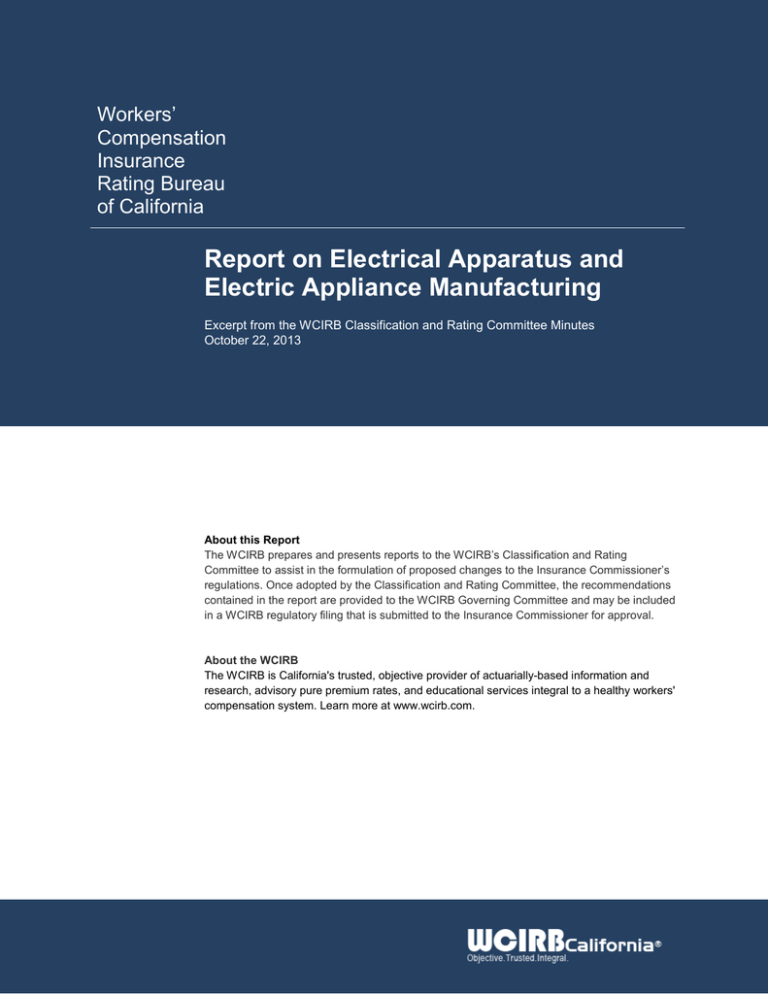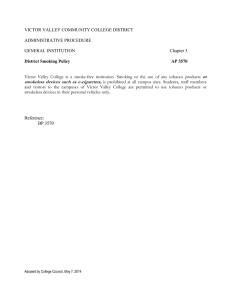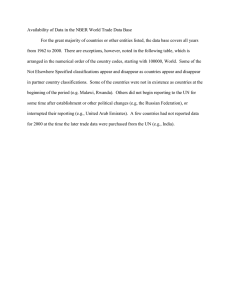
Workers’ Compensation Insurance Rating Bureau of California
®
Workers’
Compensation
Insurance
Rating Bureau
of California
Report on Electrical Apparatus and
Electric Appliance Manufacturing
Excerpt from the WCIRB Classification and Rating Committee Minutes
October 22, 2013
About this Report
The WCIRB prepares and presents reports to the WCIRB’s Classification and Rating
Committee to assist in the formulation of proposed changes to the Insurance Commissioner’s
regulations. Once adopted by the Classification and Rating Committee, the recommendations
contained in the report are provided to the WCIRB Governing Committee and may be included
in a WCIRB regulatory filing that is submitted to the Insurance Commissioner for approval.
About the WCIRB
The WCIRB is California's trusted, objective provider of actuarially-based information and
research, advisory pure premium rates, and educational services integral to a healthy workers'
compensation system. Learn more at www.wcirb.com.
Notice
This Report was developed by the Workers’ Compensation Insurance Rating Bureau of California (WCIRB) to
assist in the formulation of proposed changes to the Insurance Commissioner’s regulations. The WCIRB has
made reasonable efforts to ensure the accuracy of this Report. You must make an independent assessment
regarding the use of this Report based upon your particular facts and circumstances.
2013 Workers’ Compensation Insurance Rating Bureau of California. All rights reserved.
No part of this work may be reproduced or transmitted in any form or by any means, electronic or mechanical, including, without
limitation, photocopying and recording, or by any information storage or retrieval system without the prior written permission of the
Workers’ Compensation Insurance Rating Bureau of California (WCIRB), unless such copying is expressly permitted in this
copyright notice or by federal copyright law.
Each WCIRB member company, including any registered third-party entities, (Company) and agents and brokers licensed to
transact workers’ compensation insurance in the state of California are authorized to reproduce any part of this work solely for the
purpose of transacting workers’ compensation insurance and for no other purpose. This reproduction right does not include the
right to make any part of this work available on any Website or on any form of social media.
Workers’ Compensation Insurance Rating Bureau of California, WCIRB, WCIRB California, WCIRB Online, X-Mod Direct, eSCAD
and the WCIRB California logo (WCIRB Marks) are registered trademarks or service marks of the WCIRB. WCIRB Marks may not
be displayed or used in any manner without the WCIRB’s prior written permission. Any permitted copying of this work must
maintain any and all trademarks and/or service marks on all copies.
To seek permission to use any of the WCIRB Marks or any copyrighted material, please contact the Workers’ Compensation
Insurance Rating Bureau of California, 525 Market Street, Suite 800, San Francisco, California 94105-2767.
Released: November 11, 2013
Report on Electrical Apparatus and Electric Appliance Manufacturing
3179, Electrical Apparatus Mfg. – N.O.C.
3570, Electric Appliance Mfg. – N.O.C.
Executive Summary
Objective
Pursuant to a directive from the Classification and Rating Committee, the WCIRB is reviewing all
instances wherein the experience of two or more classifications is combined for experience rating
purposes. As part of this review, the WCIRB reviewed the current procedure of combining, for ratemaking
purposes, the experience of Classifications 3179, Electrical Apparatus Mfg., and 3570, Electric Appliance
Mfg., to determine whether to continue the long-standing procedure of combining the experience of these
classifications for ratemaking purposes.
Findings
Based on its review, the WCIRB has determined that:
1. The operations contemplated by Classification 3179 are separate, distinct and identifiable from
those contemplated by Classification 3570;
2. Classifications 3179 and 3570 each develop sufficient data to produce separate, credible advisory
pure premium rates;
3. Based on experience at policy year 2014 level, Classification 3179 has a Selected (Unlimited)
Loss to Payroll Ratio that is 1.8% less than the current Selected (Unlimited) Loss to Payroll Ratio
for Classifications 3179 and 3570 combined;
4. Based on experience at policy year 2014 level, Classification 3570 has a Selected (Unlimited)
Loss to Payroll Ratio that is 5% greater than the current Selected (Unlimited) Loss to Payroll Ratio
for Classifications 3570 and 3179 combined; and
5. Amendments should be made to Classifications 3179 and 3570 for clarity.
Recommendations
The WCIRB recommends that the following changes be made effective January 1, 2015:
1. Discontinue the combination of experience of Classifications 3179 and 3570 for ratemaking
purposes and allow each classification to develop its own advisory pure premium rate;
2. Amend Classification 3179 to include the manufacture of actuators; and
3. Amend Classification 3570 to include the manufacture of battery chargers and battery pack
assemblies.
1
WCIRB California
®
Released: November 11, 2013
Introduction
The WCIRB reviewed the procedure of combining, for ratemaking purposes, the experience of
Classifications 3179, Electrical Apparatus Mfg., and 3570, Electric Appliance Mfg. Typically,
classifications are combined for ratemaking purposes for the following reasons:
1. Similarity in Operations
Classifications are combined for ratemaking purposes when the proper classification may be
difficult to determine due to a significant similarity in operations, for example, a clear delineation
does not exist between the two classifications.
2. Low Statistical Credibility
The experience of two or more classifications is combined for ratemaking purposes when one or
more of the classifications lack statistical credibility. Although the classification(s) may be clearly
defined, due to insufficient statistical credibility, the classifications are combined based on
similarity in industry type and operations.
3. Temporary Variance in Experience
There is a temporary dissimilarity in the relative experience of the two related classifications that
results in a relationship between the relativities for the classifications that are not expected to
continue into the future. That is, based on historical experience for each classification and other
factors, there is a high likelihood that the advisory pure premium rate relativities for the
classifications will change.
With respect to the combination of experience of Classifications 3179 and 3570, this report focuses on:
1. Whether Classifications 3179 and 3570 describe two separate and distinct industries that would
permit, from a classification administration standpoint, the development of accurate advisory pure
premium rates. If so,
2. Whether there is sufficient data to produce statistically credible advisory pure premium rates for
Classifications 3179 and 3570.
Classification History
The history of Classifications 3179 and 3570 is as follows:
1915: Originally, all electrical apparatus and component manufacturing was assigned to
Classification 3643, Electrical Apparatus Mfg.
1930: Classification 3179, Electrical Apparatus Mfg., was established to specifically address the
manufacture and repair of small household-type electrical appliances. Classification 3179 also
applied to the manufacture of electrical components, coils, heater elements, connectors, and
filters. As technology progressed, electronic elements including resistors, capacitors, relays and
coils were assigned to Classification 3179.
1965: Classification 3178, Electronic Element Mfg., was established to apply to the manufacture
of electronic elements including, but not limited to resistors, capacitors, relays and coils,
previously assigned to Classification 3179.
1996: Classification 3570, Electric Appliance Mfg., was established. Classification 3570 was
combined with Classification 3179 for ratemaking purposes to provide rate stability and to monitor
the application of each classification.
2
WCIRB California
®
Released: November 11, 2013
Description of Operations
Following are the classification phraseologies, footnotes and relevant summaries of operations currently
assigned to Classifications 3179, Electrical Apparatus Mfg., and 3570, Electric Appliance Mfg.
ELECTRICAL APPARATUS MFG. – N.O.C.
3179
Classification 3179 shall not be used for division of payroll in connection with
Classifications 3643(1), Electric Power or Transmission Equipment Mfg. – N.O.C., or 3643(2),
Electric Control Panel or Switchgear Mfg., unless the operation described by Classification
3179 constitutes a separate and distinct enterprise having no connection with the
operations covered by Classifications 3643(1) or 3643(2).
This classification contemplates the manufacture or repair of electrical apparatus, including, but not
limited to, electrical control and switchboard assemblies with a power rating of less than 746 watts
(one horsepower). This classification also includes, but is not limited to, the manufacture of
electrical-mechanical components such as solenoids, push button switches and relays.
Display and parts departments that are physically separated from the repair shop and sell parts
commercially shall be separately classified as 8017(7), Stores – hardware.
Classification 3179 is generally applied to the manufacture of an electrical apparatus with a power rating
of less than 746 watts (one horsepower). The manufacture of a comparable electrical apparatus having a
power rating in excess of one horsepower is assignable to Classification 3643(2), Electrical Control Panel
or Switchgear Mfg. Electrical-mechanical apparatus are mechanical components that are controlled by
electrical inputs. This includes a variety of apparatuses including, but not limited to, control panels,
switchboards assemblies, solenoids, actuators, switches and relays.
Controls and switchboards are used to control and regulate various mechanical operations. Electrical
controls include junction boxes, switching units, traffic light controls and fuse panels. Control panel
fabrication requires the integration of circuitry components, including printed circuit boards, power
supplies, switches, relays, wires harnesses, lights, displays and manual controls, into a housing chassis.
A solenoid is an electromagnetic device that converts electrical energy into mechanical energy. The
electrical energy causes a pin or rod to retract. Solenoids create a magnetic field from an electric current
and uses the magnetic field to create linear motion. The manufacture of solenoids involves winding
copper wire around a plastic or metal bobbin. The resultant coil is sealed with a liquid insulator and is
attached to wire leads. A metal pin or rod is inserted within the core of the bobbin. The assembly is
secured within a metal housing to complete.
Relays are electrically operated switches. Relays are used to control a circuit by a low-power signal, or
where several circuits must be controlled by one signal. Relays usually consist of a coil of wire wrapped
around an iron core, a movable iron armature and one or more sets of contacts.
It is noted that the manufacture of electronic digital control panels that do not perform an electricalmechanical function are assignable to Classification 3681, Instrument Mfg. – electronic – professional or
scientific.
ELECTRIC APPLIANCE MFG. — N.O.C.
3570
This classification contemplates, but is not limited to, the manufacture or repair of lighting
apparatus, flashlights, heating elements and domestic appliances such as vacuum cleaners, food
processors and hair dryers.
Display and parts departments that are physically separated from the repair shop and sell parts
commercially shall be separately classified as 8017(7), Stores – hardware.
Small household appliances are usually labor saving devices used for domestic purposes. This includes,
but is not limited to, hair dryers, waffle irons, vacuum cleaners, floor buffing machines, coffee makers, air
3
WCIRB California
®
Released: November 11, 2013
purifiers, juice extractors and air ionizers. The fabrication of these products entails assembling switches,
motors, fans, wire harnesses, cords and plastic or metal housings, with product specific components to
produce the completed product.
Electric heating devices include, but are not limited to, food warmers, flexible heater circuits to warm
circuitry that is exposed to the elements (including on an aircraft), waterbed heaters, immersion heaters
and heater elements used to heat water quickly. The common component to these devices is the heating
element. Heating elements produce heat (energy) from the resistance generated when an electric charge
is applied to a metal core. Heating elements are constructed from metal tube, roll, coil, bar or wire stock.
The stock is machined or rolled as required, insulated and secured to lead wires. The heating element is
assembled with electric cords and placed into a housing.
Electric lighting products include, but are not limited to, flashlights, automobile headlight assemblies, light
ballasts (an electrical device for starting and regulating fluorescent lamps), Christmas tree light sets and
interior LED strip lighting. Typical fabrication involves the assembly of switches, light bulbs, light emitting
diodes, lens caps, electrical wire, springs and metal or plastic casings. It is not uncommon for lighting
product manufacturers to engage in the fabrication of metal or plastic component parts.
Classification 3570 contemplates the manufacture of battery pack assemblies that are used to power
electronic devices. The fabrication involves soldering metal tab connectors onto batteries, and arranging
them into the desired configuration. The assembly is shrink-wrapped in a plastic case. More complex
battery pack assemblies involve the integration of electronic circuit boards, wiring, and contacts. The
assemblies are placed into purchased plastic or metal housings.
Classification Analysis
Based on the description of operations provided above, firms assigned to Classification 3179
manufacture devices and components that primarily are used to perform electrical-mechanical functions
by converting energy. Firms assigned to Classification 3570 primarily manufacture electric appliances
used to perform specific tasks.
The WCIRB’s inspection report library shows that the major categories of products assigned to
Classification 3179 include control panels and control systems, switches, and actuators. The major
categories of products assigned to Classification 3570 include household appliances, lighting and lighting
apparatuses, battery chargers and battery pack assemblies, and heaters/heating elements. Household
appliances include vacuums, coffee machines, cooling fans, and other domestic equipment. As displayed
below, the end products fabricated by both classes are distinct and the functions of the end products are
different.
4
WCIRB California
®
Released: November 11, 2013
Sample of Electrical Apparatus Contemplated by Classification 3179:
Figures 1 & 2: Control panels
Figure 3: Solenoids
Figure 4: Actuator
Electrical Appliances Contemplated by Classification 3570:
Figure 5: Vacuums, various home appliances and carpet cleaners
Figure 6: Auto headlights, light ballast and led strip lights
5
WCIRB California
®
Released: November 11, 2013
Figure 7: Heaters and heating elements
Figure 8: Battery charger and battery pack assembly
The firms assigned to Classification 3179 typically manufacture an electrical apparatus that is of a much
smaller scale when compared to many appliances contemplated by Classification 3570. Control panels,
switchboard assemblies, solenoids, switches, and relays will be integrated into a larger system to provide
the electrical mechanical functions needed to operate equipment or machinery. Furthermore, these
products may also convert the energy required to operate equipment or machinery.
Conversely, a majority of the products assigned to Classification 3570 are complete electrical appliances
that do not need to be connected to or assembled into equipment or machinery in order to perform its
intended function. Classification 3570 also applies to the manufacture of components, which includes
heating elements, battery packs, light ballasts, and lighting assemblies. With the exception of battery
packs, these components are described in Classification 3570.
From a classification standpoint, there appears to be no compelling reason to continue to combine
Classifications 3179 and 3570 for ratemaking purposes.
To further determine whether a clear line of demarcation exists between Classifications 3179 and 3570,
1
the WCIRB reviewed 2014 policy year Unit Statistical Reports (USR) to determine the number of
1
A USR is a record of the total exposure and the claims pertaining to a policy. At the time this report was prepared, 2010 was the
most recent policy year for which complete ratemaking data was available.
6
WCIRB California
®
Released: November 11, 2013
employers that reported payroll in both Classifications 3179 and 3570. As shown in Table 1, no
employers developed reportable payroll in both classifications.
Table 1: 2014 USR Summary – Number of Employers
For Which Payroll Was Reported in Classifications 3179 and 3570
Classification
Employers with
Payroll Reported
in Indicated
Classification
3179
1,775
0
100%
0%
3570
834
0
100%
0%
Employers with
Payroll Reported in
Both Classifications
Percent – Payroll
only Reported in
Indicated
Classification
Percent – Payroll
Reported in Both
Classifications
In a similar manner, staff determined the number of inspection reports that assign Classifications 3179
and 3570.
Table 2: Number of WCIRB Inspection Reports That Assign
Classifications 3179 and 3570
Classification
Employers
Assigned to
Indicated
Classification
3179
629
4
99.3%
0.7%
3570
378
4
98.9%
1.1%
Employers
Assigned to Both
Classifications
Percent –
Employers Assigned
only to Indicated
Classification
Percent –
Employers Assigned
to Both
Classifications
As noted above, very few employers have been assigned to both Classifications 3179 and 3570.
This information indicates that the two industries have little commonality in operations. Each classification
is clearly defined and the potential for misclassification of payroll is low. Therefore, from a classification
perspective, there appears to be no compelling reason to continue to combine Classifications 3179 and
3570 for ratemaking purposes. Accordingly, staff reviewed the payroll and loss data developed by each
group of employers to determine (1) if sufficient data is developed to produce credible advisory pure
premium rates for each group, and if so, (2) the impact on employers assigned to Classifications 3179
and 3570 that would result if unique pure premium rates are promulgated for each group.
Statistical Analysis
Table 3 presents the classification relativity data for Classification 3179 and 3570 combined at policy year
2014 level:
7
WCIRB California
®
Released: November 11, 2013
Table 3: Electrical Apparatus Mfg. (3179) and Electrical Appliance Mfg. (3750)
Classification Relativity Data at Policy Year 2014 Level
Year
Number of
Unit Statistical
Reports
Payroll
Losses
Loss to Payroll
Ratio
2009
486
425,806,819
15,258,109
3.583
2010
505
547,995,082
17,374,320
3.171
973,801,901
32,632,429
Total
Selected (Unlimited) Loss to Payroll Ratio
4.180
Credibility2
Indemnity
Medical
1.00
1.00
Tables 4 and 5 present the classification relativity data at policy year 2014 level for each classification
independently:
Table 4: Electrical Apparatus Mfg. (3179)
Classification Relativity Data at Policy Year 2014 Level
Year
Number of
Unit Statistical
Reports
Payroll
Losses
Loss to Payroll
Ratio
2009
324
347,360,882
12,724,695
3.663
2010
336
455,045,647
13,718,284
3.015
802,406,529
26,442,979
Total
Selected (Unlimited) Loss to Payroll Ratio
4.106
Credibility
Indemnity
Medical
1.00
1.00
Table 5: Electric Appliance Mfg. (3570)
2
The relativity for each classification in the upcoming policy year is determined based on a comparison of that classification’s actual
losses per $100 of payroll and the ratio of losses per $100 of payroll underlying the current pure premium rate. The ”credibilities”
assigned to a classification are the statistical weights assigned to that classification’s experience as a predictor of future claim
experience relative to the loss per $100 of payroll underlying the classification’s current pure premium rate. The predictability or
credibilities assigned to a classification’s recent historical experience depends on the volume of indemnity and medical claims
incurred during the experience period. The WCIRB strives to have classifications that are fully, or 100%, statistically credible based
on historical experience over five or fewer years, which mean that the classification’s relativity in the upcoming policy year can be
best, estimated using only the loss per $100 of payroll experience from the latest two-, three-, four- or five-year periods. The WCIRB
generally will not recommend the establishment of a new classification if the credibility factors are less than one-half (< 0.50).
8
WCIRB California
®
Released: November 11, 2013
Classification Relativity Data at Policy Year 2014 Level
Year
Number of
Unit Statistical
Reports
Payroll
Losses
Loss to Payroll
Ratio
2006
173
76,683,178
2,068,366
2.697
2007
167
82,711,760
2,954,008
3.571
2008
163
84,053,341
3,383,130
4.025
2009
162
78,445,937
2,533,414
3.230
2010
169
92,949,435
3,656,036
3.933
414,843,651
14,594,953
Total
Selected (Unlimited) Loss to Payroll Ratio
Indemnity
Medical
0.81
0.85
4.390
As shown above, Classifications 3179 and 3570 develop sufficient payroll and loss data to produce
credible advisory pure premium rates. Therefore, from a ratemaking perspective, there appears to be no
compelling reason to continue to combine Classifications 3179 and 3570 for ratemaking purposes.
Impact Analysis
For information purposes, Tables 6 and 7 depict the impact on affected policyholders if separate
classification relativities – and thus advisory pure premium rates – are established for
Classifications 3179 and 3570.
Table 6: Classifications 3179 and 3570 Combined vs. Classification 3179
Comparison of Selected (Unlimited) Loss to Payroll Ratios at Policy Year 2014 Level
Classifications
3179 and 3570
Classification 3179
Difference
4.180
4.106
-0.074 (-1.8%)
Table 7: Classifications 3179 and 3570 Combined vs. Classification 3570
Comparison of Selected (Unlimited) Loss to Payroll Ratios at Policy Year 2014 Level
Classifications
3179 and 3570
Classification 3570
Difference
4.180
4.390
+0.21 (+5.0%)
Based on experience at policy year 2014 level, Classification 3179 has a Selected (Unlimited) Loss to
Payroll Ratio that is 1.8% less than the Selected (Unlimited) Loss to Payroll Ratio for Classifications 3179
and 3570 combined; and Classification 3570 has a Selected (Unlimited) Loss to Payroll Ratio that is 5%
greater than the Selected (Unlimited) Loss to Payroll Ratio for Classifications 3179 and 3570 combined.
Accordingly, if each classification developed unique advisory pure premium rates based on its own payroll
9
WCIRB California
®
Released: November 11, 2013
and loss data at policy year 2014 level, the unique advisory pure premium rate for Classification 3179
would be 1.8% lower than the combined rate, and the unique advisory pure premium rate for
Classification 3570 would be 5.0% higher than the combined rate.
Conclusion
Based on its review of the procedure of combining Classifications 3179 and 3570 for ratemaking
purposes, the WCIRB finds that:
1. The operations contemplated by Classification 3179 are separate, distinct and identifiable from
those contemplated by Classification 3570;
2. Classifications 3179 and 3570 each develop sufficient data to produce credible advisory pure
premium rates;
3. Based on experience at policy year 2014 level, Classification 3179 has a Selected (Unlimited)
Loss to Payroll Ratio that is 1.8% less than the current Selected (Unlimited) Loss to Payroll Ratio
for Classifications 3179 and 3570 combined;
4. Based on experience at policy year 2014 level, Classification 3570 has a Selected (Unlimited)
Loss to Payroll Ratio that is 5% greater than the current Selected (Unlimited) Loss to Payroll Ratio
for Classifications 3179 and 3570 combined; and
6. Amendments should be made to Classifications 3179 and 3570 for clarity.
Recommendations
The WCIRB recommends that the following changes be made effective January 1, 2015:
1. Discontinue the combination of experience of Classifications 3179 and 3570 for ratemaking
purposes and allow each classification to develop its own advisory pure premium rate;
2. Amend Classification 3179 to include the manufacture of actuators; and
3. Amend Classification 3570 to include the manufacture of battery chargers and battery pack
assemblies.
10
WCIRB California
®
Released: November 11, 2013
Recommendation
Amend Classification 3179, Electrical Apparatus Mfg., within the Electronics Industry Group, to include
the manufacture of actuators.
PROPOSED
ELECTRONICS INDUSTRY
ELECTRICAL APPARATUS MFG. — N.O.C.
3179
Classification 3179 shall not be used for division of payroll in connection with Classifications 3643(1), Electric Power or Transmission Equipment Mfg. – N.O.C., or 3643(2), Electric
Control Panel or Switchgear Mfg., unless the operation described by Classification 3179
constitutes a separate and distinct enterprise having no connection with the operations
covered by Classifications 3643(1) or 3643(2).
This classification contemplates the manufacture or repair of electrical apparatus, including, but not
limited to, electrical control and switchboard assemblies with a power rating of less than 746 watts
(one horsepower). This classification also includes, but is not limited to, the manufacture of electrical-mechanical components such as solenoids, push button switches, actuators and relays.
Display and parts departments that are physically separated from the repair shop and sell parts
commercially shall be separately classified as 8017(7), Stores – hardware.
*
*
*
*
*
*
*
Recommendation
Amend Classification 3570, Electric Appliance Mfg., to include the manufacture of battery chargers and
battery pack assemblies.
PROPOSED
ELECTRIC APPLIANCE MFG. – N.O.C.
3570
This classification contemplates, but is not limited to, the manufacture or repair of lighting apparatus, flashlights, heating elements, battery chargers, battery pack assemblies and domestic appliances such as vacuum cleaners, food processors and hair dryers.
Display and parts departments that are physically separated from the repair shop and sell parts
commercially shall be separately classified as 8017(7), Stores – hardware.
11
WCIRB California
®
525 Market Street, Suite 800
San Francisco, CA 94105-2767
Voice 415.777.0777
Fax 415.778.7007
www.wcirb.com
wcirb@wcirb.com



